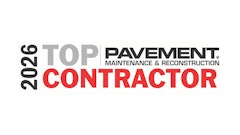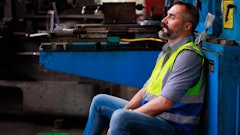
In an industry often defined by incremental improvements, VSS Macropaver has taken a bold step: combining a production-grade slurry / micro surfacing paver with fully recycled asphalt (RAP) to deliver high-performance pavement preservation solutions.
In a recent interview, Jeff Roberts, President of VSS International, walked me through how their Macropaver equipment works in a slurry seal application, the challenges and payoff of 100 % RAP use, and what this could mean for the future of pavement preservation.
 VSS Macropaver
VSS Macropaver
When I asked how the Macropaver functions in a typical slurry seal application and how it measures up to industry standards, Roberts didn't hold back praise for his product.
“The Macropaver is the most durable and efficient micro surfacing machine in the world. It has been engineered by operators for operators and has been tested around the globe.”
The machine was recognized earlier this year in Asphalt Contractor's Top 30 Products for 2025.
Roberts points to the 12-EX model’s fixed gate design, which, “Not only speeds up the calibration process but also ensures precise material flow control and enhanced consistency of the finished product being placed on the road.”
In other words, the gating ensures that the aggregate, water, and emulsion are metered strictly, reducing variation in the mix and increasing consistency across the pavement surface.
 VSS Macropaver
VSS Macropaver
Importantly, the Macropaver is fully compatible with RAP aggregates in slurry seal and micro surfacing mixtures. It doesn't require any retrofits or extensive machine conversions. This means crews familiar with traditional Macropaver operation can adopt RAP formulations with minimal additional training or cost.
Supplemental materials from VSS reinforce Macropaver’s reputation as a rugged, fast, and flexible piece of equipment suited for high production slurry and micro surfacing work. My real curiosity, however, became fixated on this efficient use of old millings.
Why Adopt 100 % RAP in Slurry Mixes?
Switching from conventional virgin aggregates to 100% RAP in slurry or micro surfacing is not a trivial shift. When I asked what motivated VSS to experiment and implement 100% RAP mixes (and what obstacles the team encountered), Roberts said, “What initially led us to using RAP in our mixes was that we had several agency customers who had mountains of RAP materials that were not being utilized. We recognized that there could be potential cost savings to all stakeholders if we could utilize these materials since RAP is significantly cheaper than virgin aggregates and asphalt binder.”
This is something I hear quite frequently from contractors and DOTs around the country. There's more than enough RAP laying around, and never enough effective uses to go around.
 VSS Macropaver
VSS Macropaver
He cites a dual benefit: cost savings on materials and hauling, and conservation of natural resources. In many cases, agencies already own the RAP material but lack strategies to put it to use. However, the switch is not fully plug-and-play.
“The biggest challenge with getting the mix right is making sure that we isolate consistent piles of RAP materials that we can use for mix design purposes and make sure that the materials being used on site are representative of the materials we designed around for our job mix formula. Once that is done it is important to make sure that all machines have been properly calibrated with these same materials.”
In practice, this means tight quality control on stockpiling, sampling, and ensuring that the on-site RAP matches the laboratory feedstock. Without that match, the risk of off-spec performance rises. This isn't too different from what we've heard from our friends at Green Asphalt, who produce batches of 100% RAP asphalt for use on public roads in New York City.
Performance, Durability, and Ride Quality: How RAP Slurry Measures Up
One natural concern, and one I raised, is whether a 100% RAP slurry seal can match or exceed the performance of conventional mixes. Roberts’s response is cautiously confident:
“The performance of a RAP slurry seal should be the same as a conventional slurry mixture with virgin aggregates as long as the base RAP materials are properly tested to ensure that the finished RAP product being used in consistent with the job mix formula provided for the job.”
 VSS Macropaver
VSS Macropaver
He further added,“If properly processed and incorporated, RAP can contribute to improved mix durability and performance.”
In effect, the key caveat is “if managed well.” Proper testing, consistent stockpiles, and strict adherence to mix design are nonnegotiable. If those controls are in place, he contends that ride quality, curing times, and long-term integrity need not suffer.
Environmental and Cost Benefits: Turning Waste Into Value
Beyond the technical performance, Roberts emphasized that sustainability and cost efficiency are core to VSS’s pitch to clients.
“We like to communicate to project owners that reusing RAP reduces the environmental footprint by conserving natural resources using an asset that, in most cases, they already own and most likely are underutilizing," He said. "RAP use also decreases the need for landfill disposal of old asphalt and reduces greenhouse gas emissions from production and transport of new materials.”
This is a strong message. Many agencies struggle with stockpiled RAP or limited landfill capacity. By converting that “waste” into a functional treatment layer, agencies gain not just cost avoidance but also a narrative advantage in lifecycle stewardship.
Troubleshooting: Operational and Technical Challenges
I pressed on whether the VSS team ran into unexpected problems during production or placement. Were there any issues related to material handling, moisture sensitivity, calibration issues, or machine limitations.
Roberts acknowledged that RAP is more commonly used in hot mix applications but said that the Macropaver handles slurry mixes just fine.
“RAP is more commonly used in hot mix asphalt (HMA) than slurry seals and micro surfacing now due to several factors," he said. "When utilizing RAP in cold mixes, you don’t necessarily achieve the same benefits due to the lack of heat in the system. Otherwise, we have had very few problems with slurry mixtures as long as the stockpiles are managed to limit inconsistencies and mix design sensitivity. The Macropavers themselves handle the RAP aggregates just fine and require no modifications to produce a high-quality mixture using RAP materials.”
One operational best practice, however, stands out. For RAP slurry seal mixes, they require the use of a pneumatic roller after placement which is not necessary for all slurry seal or micro surfacing mixtures. That pneumatic roller step helps place the aggregate before initial cure, and it's particularly useful when working with less-than-perfect RAP gradations or moisture fluctuations.
 VSS Macropaver
VSS Macropaver
Market Reception and Growing Demand
Given the novelty of 100% RAP slurry, I asked how client agencies and DOTs react to it, and whether interest in it is growing.
“The concepts of sustainability and economic savings have been received very well by local agencies. Pavement preservation is a rapidly growing industry. Sustainability is and always has been a major advantage for buying agencies and private clients in that preservation techniques typically require less materials, heat and energy to produce, transport and place on the road.”
He predicts a natural evolution in the way things are done.
“The use of RAP mixtures will naturally evolve over time and those who have access to large RAP piles will naturally use them to seek financial advantages as long as industry performance standards can be met and maintained.”
He also sees the broader context: pavement preservation provides a strong life-cycle cost argument against more capital-intensive overlays or reconstruction. Used judiciously, preservation with recycled materials can strengthen that argument.
Scaling Up: Toward a New Standard in Preservation
Finally, I asked whether Roberts believes that recycled slurry or micro surfacing treatments could become standard—and what it would take to scale adoption across the industry.
“I believe that recycled treatments will become a standard in pavement preservation applications in the future. The equipment required to do this work is already working in the market. The key is stockpile availability and the proper management of those stockpiles.”
For higher-volume roadways or state DOT work, he expects that a blend of RAP and virgin material may be required to smooth variability.
“We may find that we need to utilize an aggregate source that contains more of a blend of RAP and virgin materials to ensure better consistency in our stockpile sources. This may require greater interest from local aggregate suppliers to provide these products.”
Roberts underscored the ongoing need for data, standards, and training going forward.
“There is still a lot that our industry needs to learn about using RAP in these techniques but much of this work is being done today throughout the United States. Industry Associations like the International Slurry Surfacing Association (ISSA) have made RAP use part of their strategic plan and they are working hard to collect the data from its members and ‘connect the dots’ for the benefit of the entire industry and the agencies they serve. This will help develop better standards and training for all.”
By aligning innovation with association efforts and real-world trials, he envisioned a future where recycled slurry is not niche but routine. The VSS Macropaver and the use of a 100% RAP slurry strategy represents one of the more aggressive sustainability pivots in pavement preservation.
With that boldness comes actionable lessons and cautions, especially as it concerns quality control, stockpile management, and performance verification. But it represents a great use for recycled material, while stretching DOT and municipal budgets.


![Lee Boy Facility 2025 17 Use[16]](https://img.forconstructionpros.com/mindful/acbm/workspaces/default/uploads/2025/09/leeboy-facility-2025-17-use16.AbONDzEzbV.jpg?auto=format%2Ccompress&fit=crop&h=100&q=70&w=100)


![Lee Boy Facility 2025 17 Use[16]](https://img.forconstructionpros.com/mindful/acbm/workspaces/default/uploads/2025/09/leeboy-facility-2025-17-use16.AbONDzEzbV.jpg?auto=format%2Ccompress&fit=crop&h=167&q=70&w=250)





![Lee Boy Facility 2025 17 Use[16]](https://img.forconstructionpros.com/mindful/acbm/workspaces/default/uploads/2025/09/leeboy-facility-2025-17-use16.AbONDzEzbV.jpg?ar=16%3A9&auto=format%2Ccompress&fit=crop&h=135&q=70&w=240)


